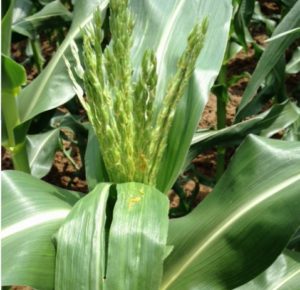Sweet Corn
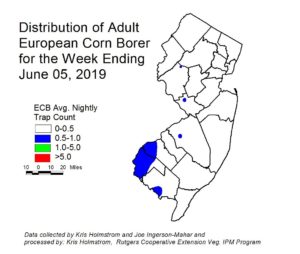 European corn borer (ECB) moths catches have declined somewhat over the past week. Overall this flight was very low, and appears to be on the way out. The majority of moth activity at this time is along the Delaware Bay Shore (see map at left). Feeding percentages should increase for the next 2 weeks, as eggs that have been deposited hatch. As of this week, feeding percentages as high as 8-10% were found in whorl corn in Burlington County. It is likely that feeding has exceeded the 12% threshold in many southern NJ plantings.
European corn borer (ECB) moths catches have declined somewhat over the past week. Overall this flight was very low, and appears to be on the way out. The majority of moth activity at this time is along the Delaware Bay Shore (see map at left). Feeding percentages should increase for the next 2 weeks, as eggs that have been deposited hatch. As of this week, feeding percentages as high as 8-10% were found in whorl corn in Burlington County. It is likely that feeding has exceeded the 12% threshold in many southern NJ plantings.
Growers should scout whorl and pre-tassel stage plantings weekly. Look for the characteristic “shot-hole” type of feeding (photo below at right) and consider treating when infested plants exceed 12% in a 50 plant sample. As plantings proceed to the pre-tassel stage, ECB larvae may be found in emerging tassels (see photo at left). It is a good idea to treat individual plantings as they move into the full tassel/first silk stage one time. This eliminates any ECB larvae that have emerged with the tassels as they begin to move down the stalk to re-enter near developing ears.
Useful insecticides for this particular application include synthetic 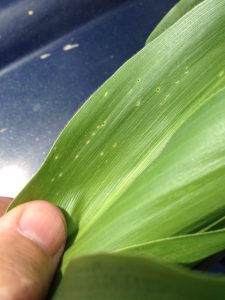 pyrethroids (IRAC Grp 3), spinosyns (including OMRI approved Entrust) IRAC Grp 5), and diamides such as Coragen (IRAC Grp 28) or materials such as Besiege which include the active ingredient in Coragen. Synthetic pyrethroids alone should NOT be used for corn earworm (CEW) protection on silking corn. Control with these materials is very inconsistent.
pyrethroids (IRAC Grp 3), spinosyns (including OMRI approved Entrust) IRAC Grp 5), and diamides such as Coragen (IRAC Grp 28) or materials such as Besiege which include the active ingredient in Coragen. Synthetic pyrethroids alone should NOT be used for corn earworm (CEW) protection on silking corn. Control with these materials is very inconsistent.
The highest nightly trap catches of ECB for the week ending 6/05/19 are as follows:
| Allentown 1 | Crosswicks 1 | Jones Island 1 | Pennington 1 |
| Califon 1 | Folsom 1 | Medford 1 | South Branch 1 |
| Centerton 1 | Georgetown 1 | New Egypt 1 | Woodstown 1 |
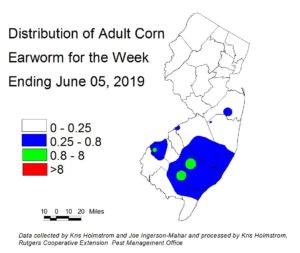 Corn earworm (CEW) moth catches continue in southern and central NJ blacklight traps through late last week (see blacklight map at left). Early plantings, now silking, are at risk of infestation from this pest. No trap captured more than 1 CEW/night in this region.
Corn earworm (CEW) moth catches continue in southern and central NJ blacklight traps through late last week (see blacklight map at left). Early plantings, now silking, are at risk of infestation from this pest. No trap captured more than 1 CEW/night in this region.
There are only very limited CEW pheromone traps operating at this time, and the full network should be operational by the end of next week. Catches this week indicate an economically significant population in the southern counties.
The highest nightly trap catches of CEW pheromone trap catches for the week ending 6/05/19 are as follows:
| Monroreville 53 | East Vineland 9 | Jobstown 8 |
| Beckett 11 | Woodstown 9 | Berlin 3 |
Silking Spray Schedules*:
South – 4-5 days
Central – 6 days
*These recommendations are based on regional catches. Adhere to tighter spray schedules if indicated by local trap catches.
Cole Crops
Imported cabbageworm (ICW) and diamondback moth larvae (DBM) infestations continue, with DBM (see photo at right) being the dominant species. DBM is especially heavy where populations of wild mustard are present in and around the fields. These infestations will increase rapidly as the spring season progresses. Check 5 consecutive plants each in 10 random locations throughout the planting, paying 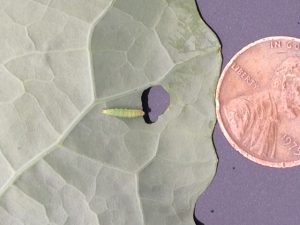 particular attention to the innermost leaves where ICW often feed. Consider treating if caterpillars are found on 10% or more plants that are in the 0-9 true leaf stage. From 9-leaf to the early head stage (in broccoli, cauliflower, and cabbage) infestations up to 20% may be tolerated. Once heads begin to form, a 5% threshold should be observed to protect the marketable portion of the plant. For leafy greens such as collards and kale, 10% plants infested is the threshold throughout.
particular attention to the innermost leaves where ICW often feed. Consider treating if caterpillars are found on 10% or more plants that are in the 0-9 true leaf stage. From 9-leaf to the early head stage (in broccoli, cauliflower, and cabbage) infestations up to 20% may be tolerated. Once heads begin to form, a 5% threshold should be observed to protect the marketable portion of the plant. For leafy greens such as collards and kale, 10% plants infested is the threshold throughout.
As a reminder: Some populations of DBM are resistant to carbamate and synthetic pyrethroid insecticides. The lack of DBM control with these insecticides has been noted in NJ previously. It is important to distinguish between common cole crop pests for this reason. DBM larvae grow to a length of approximately 0.5”, and taper toward both ends. These caterpillars thrash violently when disturbed. ICW grow to a length of approximately 1.25” and are covered with short hairs. Newer chemistries that specifically target caterpillar pests are effective against DBM as well as all other caterpillar pests of cole crops. These materials include (active ingredient – trade name (IRAC* code)):
Spinosad/Spinetoram – Entrust/ Radiant (5)
Chlorantraniliprole – Coragen (28)
Cyantraniliprole – Exirel (28)
The IRAC group 5 insecticide, Entrust, is OMRI approved for organic production. Insecticides based on the soil-inhabiting bacterium Bacilllus thuringiensis (B.t.) may also be effective on caterpillar pests of cole crops. Examples include Xentari and Javelin.
Tomatoes
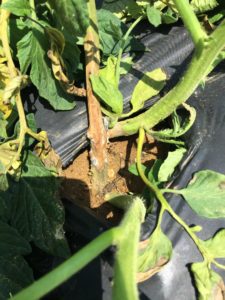 Timber rot (Sclerotinia) (photo at left) is showing up in many field and high tunnel grown tomatoes at this time. This fungal disease is favored by wet conditions and cool temperatures. Spores infect t
Timber rot (Sclerotinia) (photo at left) is showing up in many field and high tunnel grown tomatoes at this time. This fungal disease is favored by wet conditions and cool temperatures. Spores infect t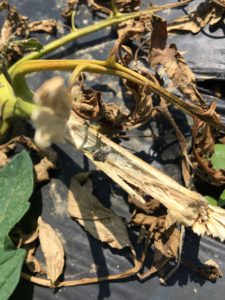 he main stems of the plants, causing them to wilt, with the stems turning dry and brittle. Closer inspection of these lesions will show the black sclerotia (photo at right), as are characteristic of this disease. These pellet-like masses of fungal tissue will drop to the ground as the plant deteriorates, and will serve as inoculum for the following season. For this reason, infected plants should be removed from the field or high tunnel. Sclerotinia can infect tomatoes, peppers, beans, lettuce and brassica crops.
he main stems of the plants, causing them to wilt, with the stems turning dry and brittle. Closer inspection of these lesions will show the black sclerotia (photo at right), as are characteristic of this disease. These pellet-like masses of fungal tissue will drop to the ground as the plant deteriorates, and will serve as inoculum for the following season. For this reason, infected plants should be removed from the field or high tunnel. Sclerotinia can infect tomatoes, peppers, beans, lettuce and brassica crops.
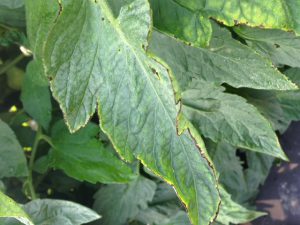 Bacterial leaf spot infections (see photo at left) have begun to appear in some fields following heavy rains. Look for very dark lesions on leaf margins, and on the interior of immature leaves. Lesions will have chlorotic borders and may cause immature leaves not to expand properly. Growers should treat preventively for this disease prior to symptoms. See the tomato section of the 2019 Commercial Vegetable Recommendations Guide for materials and spray schedules.
Bacterial leaf spot infections (see photo at left) have begun to appear in some fields following heavy rains. Look for very dark lesions on leaf margins, and on the interior of immature leaves. Lesions will have chlorotic borders and may cause immature leaves not to expand properly. Growers should treat preventively for this disease prior to symptoms. See the tomato section of the 2019 Commercial Vegetable Recommendations Guide for materials and spray schedules.
Peppers
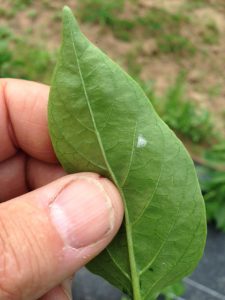 With declining ECB moth activity, growers should be looking for ECB egg masses (see photo at left) on the underside of pepper leaves. The larvae that hatch from these eggs will bore into the central stem of pepper plants in the absence of suitable fruit. This damage causes the tops of the plant to die, and eliminating the crown set of fruit in the process. Check 2 leaves per plant on 5 consecutive plants in 10 random locations. Consider treating if 2 or more leaves are found to have ECB larvae on the lower surface.
With declining ECB moth activity, growers should be looking for ECB egg masses (see photo at left) on the underside of pepper leaves. The larvae that hatch from these eggs will bore into the central stem of pepper plants in the absence of suitable fruit. This damage causes the tops of the plant to die, and eliminating the crown set of fruit in the process. Check 2 leaves per plant on 5 consecutive plants in 10 random locations. Consider treating if 2 or more leaves are found to have ECB larvae on the lower surface.
